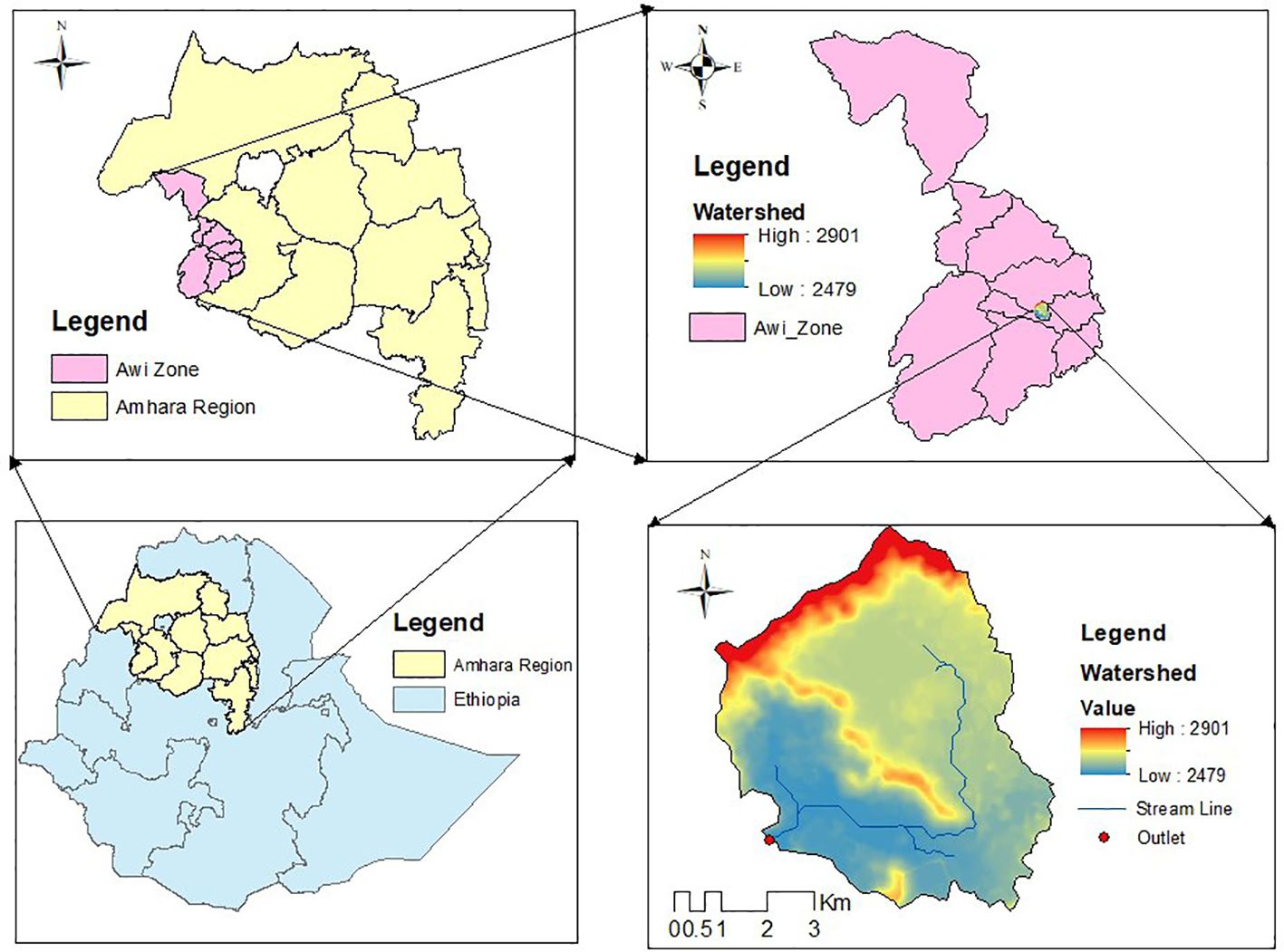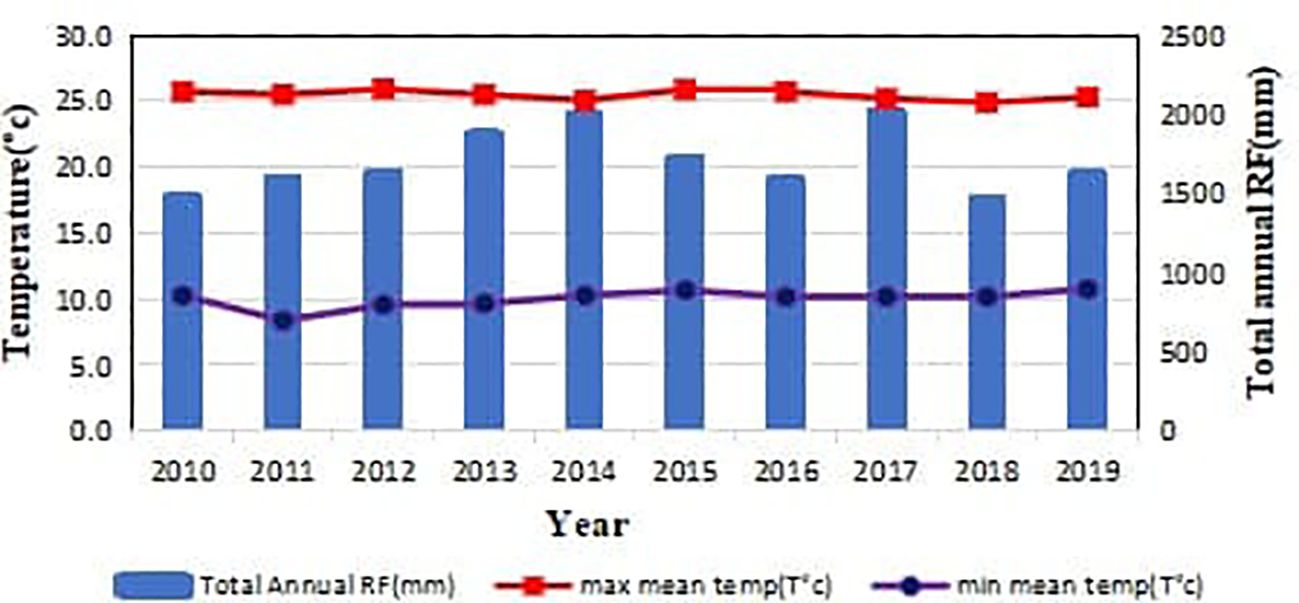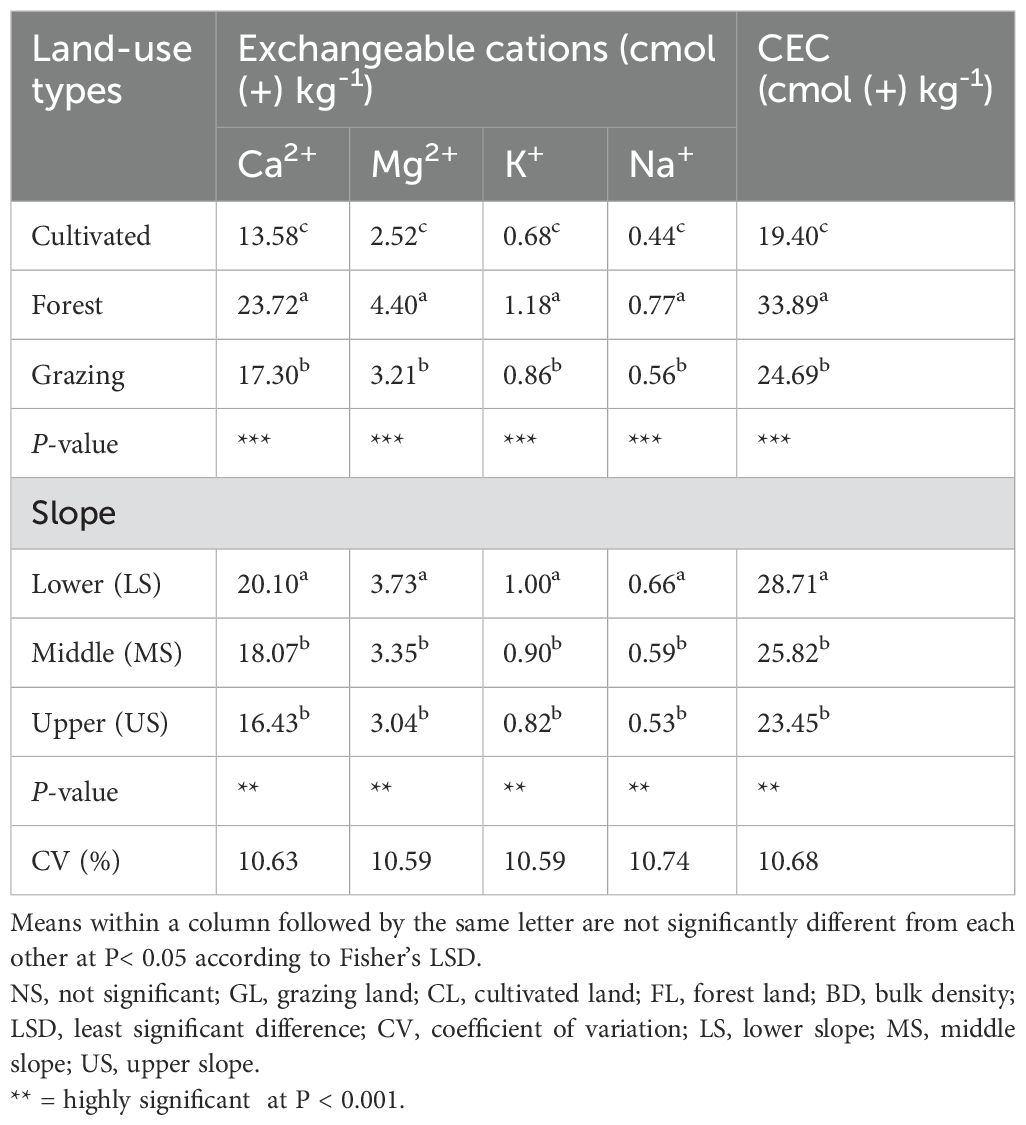- 1Natural Resources Management Department, Wolayitasodo University, Wolayitasodo, Ethiopia
- 2Natural Resources Management Department, Injibara University, Injibara, Ethiopia
Aims: This study examines the effects of land-use types and slope position on selected soil physico-chemical properties in the Ageza Watershed, Northwestern Ethiopia, focusing on soil fertility depletion and its impact on agricultural productivity.
Materials and methods: The experiment utilized a randomized complete block design (RCBD) with three replications, involving three land-use types and slope positions. A total of 27 soil samples (both disturbed and undisturbed) were collected, prepared, and analyzed for selected physico-chemical properties following standard laboratory procedures. Data were analyzed using two-way ANOVA with SAS software.
Results: Significant variations in most soil physico-chemical properties were observed across land-use types and slope positions. Soil bulk density, organic carbon (OC), total nitrogen (TN), available phosphorus (Av. P), cation exchange capacity (CEC), and exchangeable bases significantly (P ≤ 0.001) differed among the land-use types and slope positions. The main effects showed significant (P ≤ 0.05) differences in sand, silt, and clay contents across the land-use types. However, pH did not show significant differences (P > 0.05). Soil bulk density, silt content, Av. P, exchangeable bases, and CEC all showed significant (P ≤ 0.01) differences among the slope positions. Forest land had the highest values for clay (46.11%), OC (6.08%), Av. P (20.60 mg/kg), CEC (33.89 cmol (+) kg-¹), and exchangeable cations: Ca²+ (23.72 cmol (+) kg-¹), Mg²+ (4.40 cmol (+) kg-¹), K+ (1.18 cmol (+) kg-¹), and Na+ (0.77 cmol (+) kg-¹). Grazing land exhibited higher silt and bulk density, while cultivated land had higher sand content. Lower slope positions recorded the highest values for clay (47.33%), silt (20.77%), pH (4.90), Av. P (16.61 mg/kg), Ca²+ (20.10 cmol (+) kg-¹), Mg²+ (3.73 cmol (+) kg-¹), K+ (1.00 cmol (+) kg-¹), Na+ (0.66 cmol (+) kg-¹), and CEC (28.71 cmol (+) kg-¹), while bulk density was higher in the upper slope position.
Conclusion: Land-use types and slope positions significantly influence variations in soil physico-chemical properties and overall soil fertility status. Forest preservation and management are essential to improve the soil fertility in this region.
Introduction
The decline in soil productivity in Africa can be attributed to inappropriate land-use practices that lead to nutrient depletion and soil erosion (1, 2). Negative nutrient balances in Sub-Saharan Africa (SSA) are the primary causes of declining per-capital food production (3). Ethiopian highland areas are characterized by high rainfall and have continually practiced diversified cultivation with rapid land-use changes (4). In Ethiopia, land-use changes, such as conversion of natural vegetation to cultivated land, result in rapid nutrient depletion from the soils (5). Due to continuous agriculture and overgrazing, half of Ethiopia’s farmland is moderately to strictly degraded and nutritionally depleted (6). Intensive and continuous cultivation of land without proper management resulted in a decline in soil physical, chemical, and biological properties which aggravates crop yield reduction and food insecurity (7, 8). also noted that continuous cultivation and application of acid-forming fertilizers affect the transformation and availability of macro- and micro-nutrients.
Topography or slope position affects soil properties by influencing water movement, erosion, and deposition. Steeper slopes experience quicker water runoff, leading to reduced water retention and higher erosion rates, which result in thinner and less fertile soils (9). In contrast, gentle slopes and flat areas facilitate water infiltration and retention, allowing for deeper soil development and higher fertility owing to the accumulation of sediments and organic matter (10). This difference also affects soil parameters, including soil bulk density, total porosity, water-holding capacity, clay content, and organic matter content, all of which play critical roles in determining soil structure and fertility. The total nitrogen and cation exchange capacity (CEC) are crucial for nutrient availability and retention. These factors directly influence crop yield and quality by affecting root growth, water availability, and the soil’s ability to retain and supply essential nutrients. Total nitrogen and cation exchange capacity (CEC) are crucial for nutrient availability and retention, ensuring that crops have access to the nutrients needed for optimal growth and development. High levels of nitrogen are particularly important to promote vegetative growth and the protein content in crops, while a higher CEC indicates a greater capacity of the soil to hold and exchange nutrients, enhancing overall soil fertility. These variations can significantly impact the nutrient profile of the soil, further influencing crop yield and quality by affecting plant metabolism, growth rates, and resistance to diseases. Additionally (11), reported that the availability of micronutrients, along with exchangeable bases, such as calcium (Ca²+), magnesium (Mg²+), potassium (K+), and sodium (Na+), varies across different slope positions, affecting the overall nutrient profile of the soil. Losing topsoil through erosion contributes to loss of inherent soil fertility levels of nitrogen (N), phosphorus (P), and potassium (K) and thus to a decline in potential crop yields (12).
Nevertheless, studies of soil physico-chemical properties concerning land-use types and slope positions effect at the local level have not been well documented due to the limited research on their combined impact in this particular region. Understanding soil physico-chemical properties for agricultural productivity, environmental sustainability, or sound management of land resources and minimizing soil erosion in the study area have paramount importance. By examining how land-use and slopes influence these properties, the research aims to provide valuable insights that can inform land-use planning, conservation efforts, or agricultural practices in the region. By addressing the research gap and providing a clear rationale, the study can contribute meaningfully to the existing body of knowledge and potentially have practical implications for stakeholders in the region.
Materials and methods
Description of the study area
The present study was conducted at Ageza watershed, northwestern Ethiopia (Figure 1). Astronomically, the watershed is located at 10°56′27.53″ latitude and 36°52′27.55″ longitude. The altitude of the watershed ranges from 1,800 to 2,953 msl. According to the National Meteorology Agency of Bahir Dar Meteorology Station weather data from 2010 to 2019, the mean minimum and maximum temperatures of the study area were 12.98°C and 26.26°C, respectively. The mean annual rainfall is 1,864.13 mm, with the main wet season being from June to September (Figure 2). Moreover, the soil types of the study area are Nitisols, characterized as shallow, moderate to deep, and very deep in depth and sandy clay to clay textural types (13).
Land-use types and management systems
The study area is characterized by a mixed farming system with the dominant crops of wheat (Triticum aestivum), potato (Solanum tubersoum), barely (Hordeum vulgare), and maize (Zea mays L.). The study area has also great potential for forest plantation, especially Eucalyptus globules, Acacia decurrences, and Cupresses lustanica tree species which are widely planted. In the watershed, there are different land-use types: cultivated (CL), natural forest (NL), grazing (GL), and plantation lands (EP). The share of land-use types of the watershed was 37.5%, 25%, 12.5%, and 12.5% cultivated, grazing, natural forest, and plantation lands, respectively (Banja District Agriculture Office, 2020).
Crop production is widely practiced through traditional subsistence farming on individual land holding under rain-fed agriculture. Agriculture is dependent upon rainfall, and land is cultivated using a horse and other draft animals. The natural vegetation of the present study area is very scattered, except for some trees and grasses in certain areas. The land management systems for the cultivation of such crops in the watershed include terracing, repeated contour plowing, application of chemical fertilizers and herbicide, composting, and hand weeding. However, there is no practice of fallowing in the watershed due to a shortage of land and high population pressure.
Experimental design and sampling techniques
The experiment was designed using a fractional combination of three land-use types—cultivated land (CL), grazing land (GL), and forest land (FL)—and three slope positions—upper slopes (>30%), middle slopes (15%–30%), and lower slopes (<15%)—according to FAO (2006). The layout followed a randomized complete block design (RCBD) with three replications. Composite soil samples were collected from each sampling block (10 m × 10 m in size) using auger. The soil samples were then taken from nine (9) points in an “X” pattern, and undisturbed soil samples were also taken by using core ring to investigate soil bulk density (BD). For soil physical property analysis, 27 undisturbed soil samples were taken from the deep (0–20 cm) through a steel core sampler. At each land-use type, three slope positions were selected from similar altitude and soil types. Global positioning system (GPS) and clinometers were used to read the geographical locations and slopes of the sampling sites of selected land-uses, respectively. Dead plants, furrows, old manures, wet spots, areas near trees, and the like were excluded during collection of the spill samples. The composited soil samples were collected from representative land-uses and slope positions with three replications.
Soil laboratory analysis
Soil texture was analyzed by using the Bouyoucos hydrometer method (14) after dispersing the soils with sodium hexamethaphosphate (NaPO3)6, and hydrogen peroxide (H2O2) was used to destroy the organic matter. From undisturbed soil samples, soil bulk density was determined using the core sampling method after drying the soil samples in an oven at 105°C until a constant weight was obtained (15). After the core sampled-soil was oven-dried, the BD was calculated by dividing the mass of the oven-dried soil (g) with the respective volume (cm3) as they are existing under natural field conditions. Total porosity (TP) was calculated using (Equation 1) from the values of BD and particle density (PD), with the latter assumed to be what we used as the average value of 2.65 g cm-3.
Soil pH was measured in a suspension of 1:2.5 soil-to-potassium-chloride (KCl) solution ratio (16). Organic carbon was analyzed using the wet oxidation method (17) with potassium dichromate (K2Cr2O7) in a sulfuric acid solution and titrated with 0.5 N ferrous sulfate solutions. Total N was determined by employing Kjeldahl digestion, distillation, and titration method (18). Soil available phosphorus (Av. P) content was determined by the Bray II method (19), with hydrochloric acid (HCl, 1 M) after extraction of phosphate determined photometrically. The exchangeable bases of calcium (Ca²+), magnesium (Mg²+), potassium (K+), and sodium (Na+) were extracted with 1 N NH4OAC (ammonium acetate) at pH 7. Exchangeable Ca²+ and Mg²+ were measured by using an atomic absorption spectrophotometer (AAS), and exchangeable K+ and Na+ were determined by using a flame photometer (20). For the determination of cation exchange capacity (CEC), the soil samples were leached with 1 N ammonium acetate solution and washed with ethanol (97%) to remove excess salt, followed by leaching with sodium chloride to displace the adsorbed (NH+4) (21). The quantity of ammonia was then measured by distillation and taken as CEC of the soil (22).
Statistical analysis
A two-way analysis of variance (ANOVA) was performed to assess the significance of differences in soil parameters between slope positions, land-use types, and its interaction effects. Data were subjected to ANOVA with the RCBD method using a statistical analysis system (23). The least significant differences (LSD) by Fisher’s test were used to separate significantly differing treatment means after main effects were found significant at P ≤ 0.05 using SAS software version 9.4. Moreover, simple correlation analyses were employed using Pearson’s correlation coefficient to determine the degree and direction of associations between selected soil physico-chemical properties.
Results and discussion
Soil physical properties
Soil texture
The clay and silt contents showed highly significant (P ≤ 0.01) and significant (P< 0.05) differences, while the sand contents were not significantly (P > 0.05) influenced by the interaction effects of land-use types and slope positions, respectively (Table 1). Considering the interaction effects of land-uses and slope positions, the highest clay (51.34%) and silt (25.06%) contents were recorded in the lower slope of FL and middle slope of GL, respectively (Table 2). The lowest clay (32.66%) and silt (15.00%) contents were recorded under CL of upper slope and CL of middle slope positions, respectively (Table 2). Cultivated land has the lowest (32.66%) clay content compared to FL and GL use types. The reason for the lowest clay in upper slope of CL might be due to the removal of clay from the surface by erosion, tillage activities, and transformation of clay minerals to other minerals by weathering and other pedogenetic processes. This agrees with the previous finding of (24) at the Abobo area, western Ethiopia. However, most of the CL in the study area lacks management practices and erosion controlling mechanisms that resulted in low clay content in the cultivated field relative to the rest of the land-use types (25).
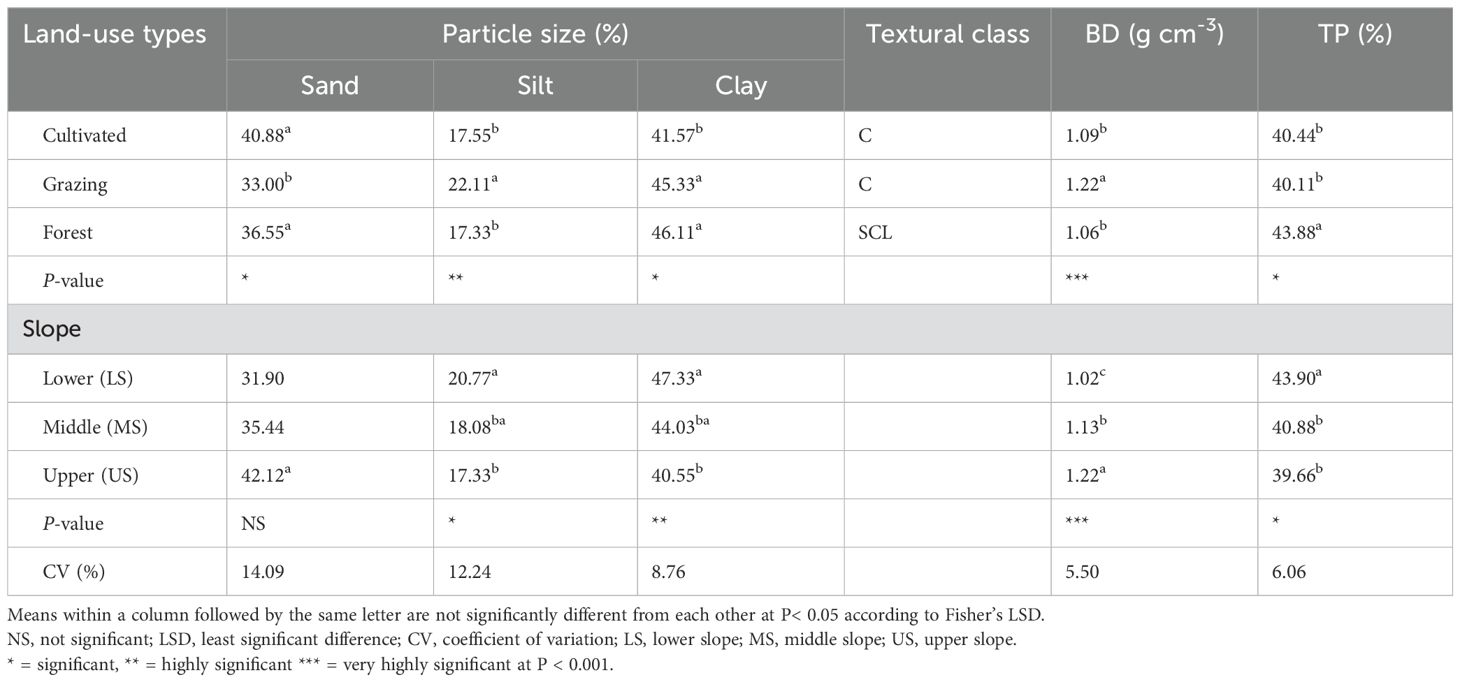
Table 1. Main effects of land-use and slopes on selected soil physical properties at Ageza watershed.
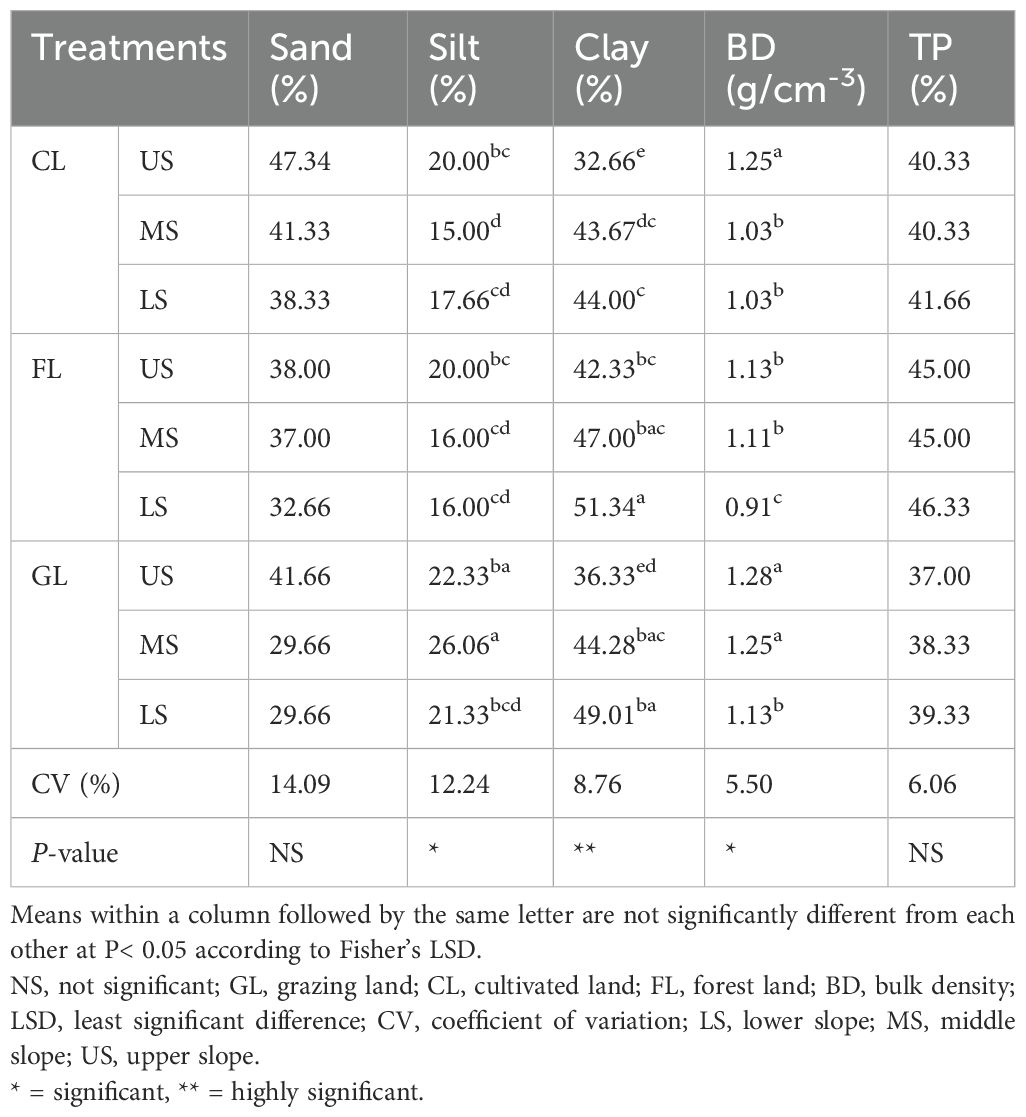
Table 2. Interaction effects of land-uses and slopes on selected soil physical properties at Ageza watershed.
Bulk density
The soil BD value was significantly (P ≤ 0.05) affected by the interaction effects of land-use types and slope positions, while the main effects of land-use types and slope positions showed very highly significant (P ≤ 0.001) differences (Tables 1, 2). Considering the interaction effects, the highest (1.28 g cm-3) and lowest (0.91 g cm-3) value of BD was recorded from GL of upper and FL of lower slopes, respectively (Table 2). This lowest BD value in FL soils is due to its highest soil organic matter (OM) content (26). The lowest bulk density value in the lower slope position was attributed to reduced compaction due to less traffic and disturbance (27), which minimized the impact of human activities on soil structure. Additionally, natural processes, such as erosion and sediment transport, help alleviate compaction by removing compacted layers, further enhancing the soil conditions in this area. The highest BD in GL of the upper slope indicates that soil compaction was enhanced due to free overgrazing pressure and livestock disturbance over trampling, especially during the rainy season (28).
Total porosity
The total porosity value was not significantly (P ≤ 0.05) affected by the interaction effects of land-use types and slope positions, while it was significantly affected by the main effects of land-use types and slope positions at P ≤0.05 (Table 1). Regarding land-use types, the highest and lowest mean value of TP (43.88%) and (40.11%) was recorded under FL and GL, respectively (Table 1). The highest soil mean TP under the soils of FL use type may be attributed to the higher OM contents, while the lowest TP might be the result of higher animal tracking in the soils of GL. A decline in TP in the soils of grazing and cultivated lands as compared to soils of FL was attributed to a reduction in pore size distribution, and it is also closely related to the magnitude of SOM loss which depends on the intensity of soil management practices (29).
Regarding slope positions, the highest (43.90%) and lowest (39.66%) mean value of TP was recorded in the lower and upper slope positions, respectively (Table 1), which might be due to high BD and low clay and OM contents in the soils of the upper slope as compared to the lower slope. In this study, TP of the soil increases with the decrease of slope gradient. Total porosity increases as BD decreases, while it decreases as BD increases (30). Higher TP can make the soil workable and will have favorable plant rooting conditions.
Soil chemical properties
Soil pH
Soil reaction (pH) was not significantly different (P > 0.05) by the interaction effects of land-use types and slope cases as well as the main effects of land-use types. However, a significant difference (P ≤ 0.05) was observed in pH among slope positions, where the highest (4.90) mean soil pH was recorded in the lower slope, followed by the middle (4.88) one, whereas the lowest (4.56) was observed in the upper slope (Table 3). The higher pH value recorded in the lower slope might be due to the removal of basic cations from higher topography positions (upper and middle slopes) by erosion and its subsequent accumulation in the lower slope. In line with this finding (31), reported that the loss of base-forming cations through leaching and runoff generated from accelerated erosion reduces soil pH and thereby increases soil acidity in the upper slope. Correspondingly (32), reported highest basic cation concentration and pH at bottom slope position (33). also reported that continuous cultivation practices, excessive precipitation, and steepness of topography could be some of the factors responsible for the reduction of soil pH at the middle and upper elevations.
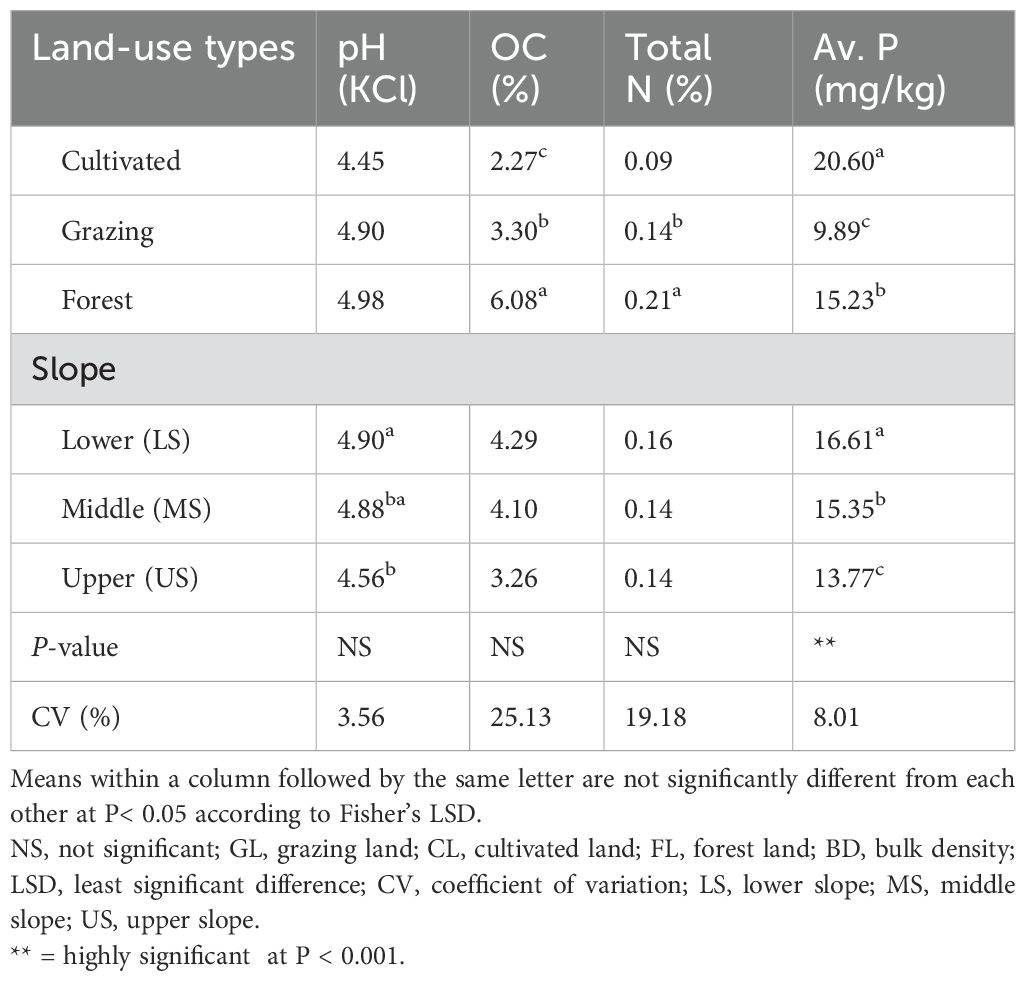
Table 3. Main effects of land-uses and slopes on pH, organic carbon, total nitrogen, and available phosphorous.
Soil organic carbon
Soil organic carbon content showed non-significance (P > 0.05) by their interaction effects of land-use types and slope positions, albeit it was very highly significantly (P ≤ 0.001) affected by land-use types (Tables 3, 4). Regarding land-use types, the highest (6.08%) mean SOC content was recorded in the FL soil, while the lowest (2.27%) was under CL. The SOC mean value has increased from CL to GL and FL, respectively (Table 3), which might be because, in FL, falling of plant materials could increase SOC. On the contrary, the lowest SOC content of CL might result from the removal of SOC through oxidation because of intensive cultivation and erosion (34). In consent to this, the study by (35) on SOC in Ethiopia implied that over-cultivation depletes SOC. Besides this (36), stated that, under the CL use type, losses of SOC were not fully compensated by organic matter inputs from the crop residues. This result is also in agreement with (37), who stated that a higher SOC content was observed in natural FL while it was lower in CL due to plant litter fall, which, in turn, enhanced the fraction of soil organic matter in soils of FL (38).
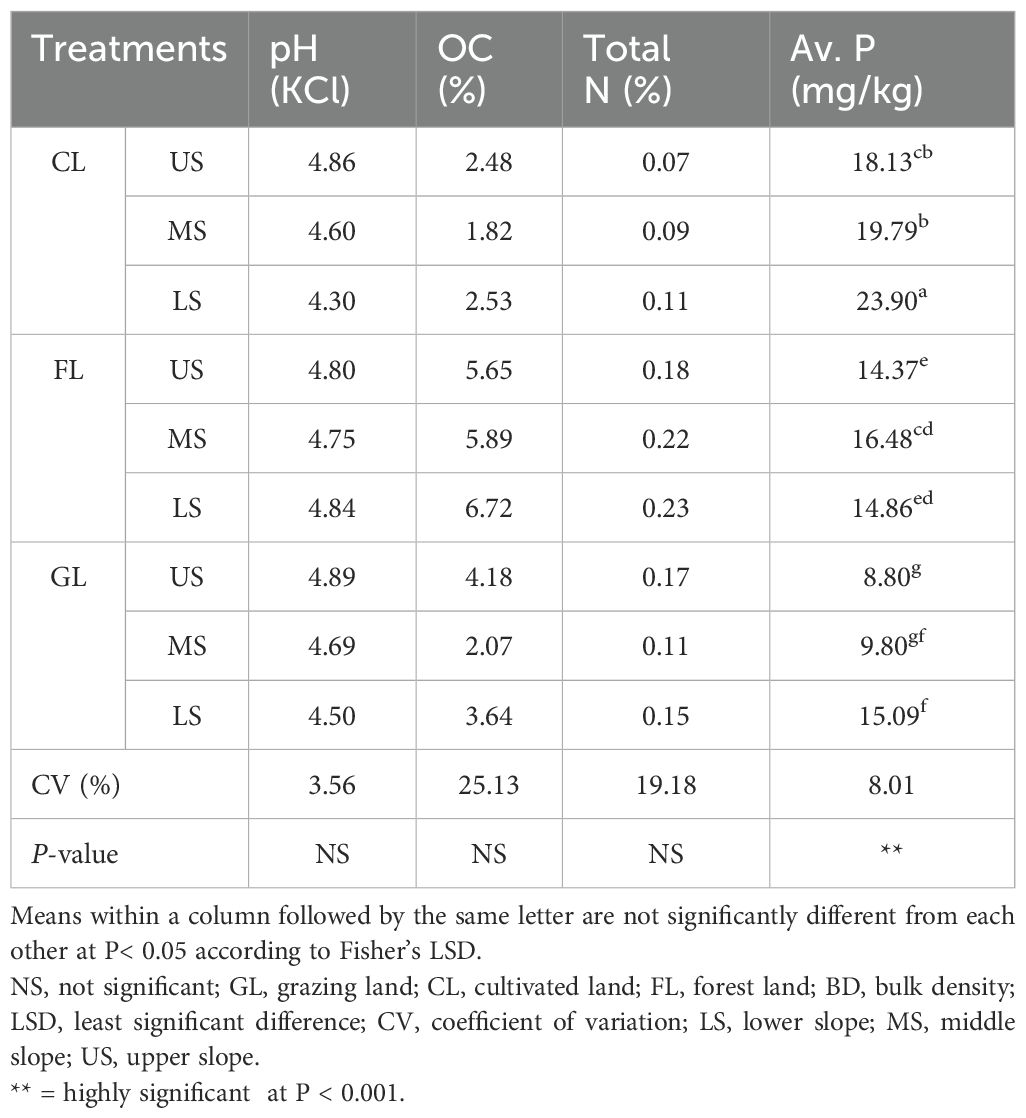
Table 4. Interaction effects of land-uses and slopes on pH, organic carbon, total nitrogen, and available phosphorous.
Total nitrogen
The TN content of the soil was non-significant (P > 0.05) by the interaction effects of land-use types and slope positions, while it was very highly significantly (P ≤ 0.001) affected by land-use types (Tables 3, 4). Based on the effect of land-uses on soil TN, the highest (0.21%) mean value was recorded under FL and the lowest (0.09%) in the CL (Table 3). This result indicated that soil TN comes from the soil OM of FL which had a high SOC content (Table 3). The low TN content recorded in the soils of the CL might be due to the rapid mineralization of soil OM. Reduced input of plant residues in such cereal-based farming systems into the soils is expected to contribute to the depletion of SOC and thereby TN in these CL soils. This finding agrees with the findings of (39), who reported that variation of TN paralleled with that of the change in SOC content in the soils of Girar Jarso of North Shoa Zone, Oromia, Ethiopia.
Furthermore (40), and (41) reported a low input of plant residues resulted in low TN. Similarly, the results of the SOC of the present study are in accordance with the findings of (42), who noted that the intensive and continuous cultivation forced the oxidation of SOC and thus resulted in a reduction of TN. Concomitantly (43), stated that OM is the main supplier of soil N, S, and P in low-input farming systems, and the continuous decline in the SOC content of soils of CL is likely to affect the soil productivity.
Available phosphorus
The ANOVA indicated that Av. P content was highly significantly (P ≤0.01) affected by the interaction effects of land-use types and slope positions; it was likewise very highly significantly (P ≤ 0.001) affected by land-use types. Considering the interaction effects of land-use types and slope positions, the highest (23.90 mg/kg) and lowest (8.80 mg/kg) value of Av. P was recorded in the cultivated land of lower slope and grazing land of upper slope positions, respectively (Table 4). The highest Av. P in the CL might be due to the continuous application of P-containing fertilizers. The results agreed with that of (44) who observed that the lowest concentration of Av. P was found under GL and highest under CL (45, 50). also reported comparable results that a high concentration of Av. P was found under CL as compared with uncultivated lands.
Cation exchange capacity
The results of ANOVA indicated that CEC was highly significantly affected by interaction effects of land-use types and slope positions (Table 5); it was likewise very highly significantly and highly significantly affected by the main effects of land-use types and slope positions (Table 6). Considering the interaction effects, the highest CEC (34.96 cmol kg-1) mean value was recorded under FL of lower slope positions and lowest (16.35 cmol kg-1) under CL of the upper slope class (Table 5). This might be because FL soil had a high clay and OM that cause a higher buffering capacity than CL. Similarly (46), reported that the amount and type of clay mineral are responsible for high CEC since both clay and organic colloids are negatively charged and can act as anions. Thus, clay and OM can absorb and hold positively charged ions (cations) (47). generalized that higher CEC values might imply that the soils have a high buffering capacity against induced change.
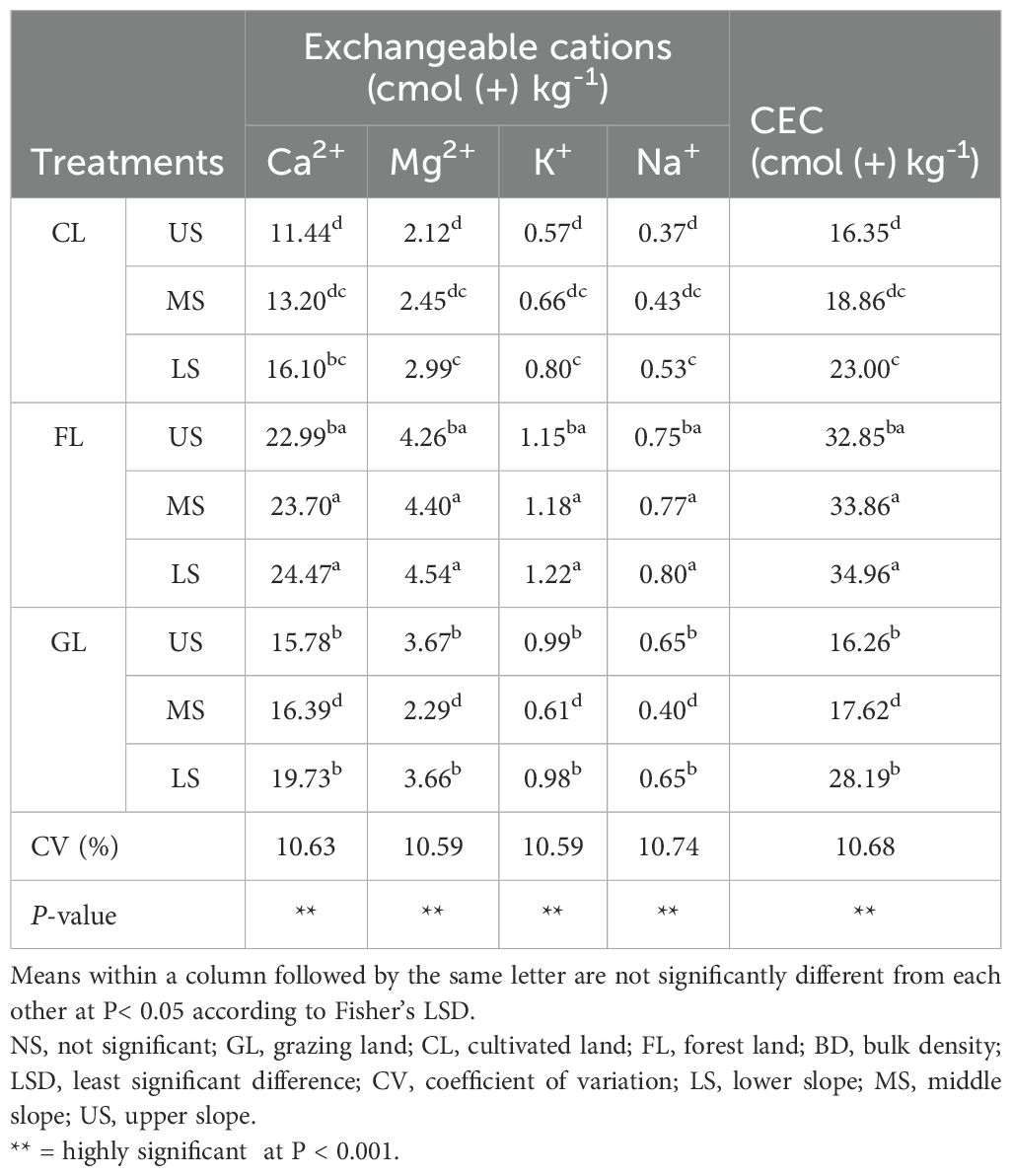
Table 5. Interaction effects of land-uses and slopes on exchangeable bases and cation exchange capacity.
Exchangeable basic cations (Ca²+, Mg²+, K+, and Na+)
Exchangeable basic cations were highly significantly (P ≤ 0.01) affected by the interaction effects of land-use types and slope positions (Table 5); it was likewise very highly significantly (P ≤ 0.001) affected by the main effects of land-use types and slope positions (Table 6). Regarding interaction effects of land-use types and slope positions in exchangeable cations, the highest Ca²+ (24.47 cmol (+) kg-1), Mg²+ (4.54 cmol (+) kg-1), K+ (1.22 cmol (+) kg-1), and Na+ (0.80 cmol (+) kg-1) and the lowest Ca²+ (11.44 cmol (+) kg-1), Mg²+ (2.12 cmol (+) kg-1), K+ (0.57 cmol (+) kg-1), and Na+ (0.37 cmol (+) kg-1) values were recorded in the FL of lower slope and CL of upper slope, respectively (Table 5). This is because of the presence of different woody species and perennial plants in FL which can add soil OM and reduce the rate of soil erosion. This result agrees with the work of (24), who reported that exchangeable soil cations were higher in FL than CL and GL.
Correlation matrix of soil physico-chemical properties
The correlation was done to describe the relationship among each soil property and parameter considered in the analysis of the present study. Bulk density was positively and significantly correlated with pH (r = 0.49**) and silt (r = 0.53**) but had a significant and negative relationship with OM (r = -0.1**) and the rest of the selected parameters. The correlation indicated that the presence of a higher clay fraction and OM content lowers soil BD. This study agrees with (48) who revealed that OM decreases BD through its positive effect on soil aggregation. Sand was positively and significantly correlated with BD (r = 0.01**) and negatively correlated with the rest of the physico-chemical properties. Similarly, clay was significantly correlated positively and negatively with pH (r = 0.06**) and BD (r = -0.2**), respectively, but negatively correlated with other soil properties. Silt was negatively and significantly correlated with BD (r = 0.53**) and sand (r = 0.14**).
Soil pH was negatively and significantly correlated with sand (r = -0.19**) and positively correlated with the rest of the physico-chemical properties. Soil OC was negatively and significantly correlated with BD (r = -0.1**), sand (r = -0.28**), and silt (r = - 0.22**) as sand particles allow further decomposition of OM and positively and significantly correlated with clay (r = 0.45**), CEC (r = 0.83**), and TN (r = 0.89**). This might be because clay is poor in aeration, resulting in slow oxidation process in the soil system. Available phosphorous was positively and significantly correlated with CEC (r = 0.79**) and all exchangeable cations Ca²+ (r = 0.77**), Mg²+ (r = 0.76**), K+ (r = 0.75**), and Na+ (r = 0.74**) and negatively and significantly correlated with BD (r = -0.004**), sand (r = -0.16**), and silt (r = -0.08**). The CEC was positively correlated with OM (r = 0.83***) and clay (r = 0.67). The CEC was also positively and significantly associated with pH (r = 0.19***) and exchangeable bases (Ca2+ (r = 0.99***), Mg2+ (r = 0.98***), K+ (r = 0.97***), and Na+ (r = 96***)), respectively. This indicates that CEC can be influenced by the contributions of soil OM and clay content.
This result was in line with the investigation of (24). Besides that (49), disclosed that the amount of clay and type of mineral present in the soils are important controlling factors for CEC. The CEC increases when the content of exchangeable bases increases in the soil and vice versa. Hence, CEC was associated positively with exchangeable bases but negatively and significantly correlated with sand (r = -0.48**) and BD (r = -0.17**).
Conclusions
The study revealed significant impacts of both land-use types and slope positions on most of the soil physico-chemical properties. Forest land demonstrated superior soil fertility, characterized by higher levels of organic carbon (OC), available phosphorus (Av. p), cation exchange capacity (CEC), and exchangeable bases, compared to grazing and cultivated lands. Lower slope positions consistently showed better soil fertility indices, including higher clay content, silt, pH, and exchangeable bases, while bulk density was higher in the upper slope position. The findings emphasize the importance of maintaining forest land and implementing appropriate land management practices, particularly in lower slope areas, to prevent soil fertility depletion and enhance agricultural productivity in the region. Sustainable land-use practices are crucial to mitigate soil degradation and ensure long-term agricultural sustainability.
Data availability statement
The raw data supporting the conclusions of this article will be made available by the authors, without undue reservation.
Author contributions
HAm: Conceptualization, Data curation, Formal analysis, Funding acquisition, Investigation, Methodology, Project administration, Resources, Software, Supervision, Validation, Visualization, Writing – original draft, Writing – review & editing. HAd: Conceptualization, Data curation, Formal analysis, Funding acquisition, Investigation, Methodology, Project administration, Resources, Software, Supervision, Validation, Visualization, Writing – original draft, Writing – review & editing. TE: Conceptualization, Data curation, Formal analysis, Funding acquisition, Investigation, Methodology, Project administration, Resources, Software, Supervision, Validation, Visualization, Writing – original draft, Writing – review & editing.
Funding
The author(s) declare that no financial support was received for the research, authorship, and/or publication of this article.
Acknowledgments
This manuscript would never have been completed without the contributions of Injibara university and Wolaita Sodo University.
Conflict of interest
The authors declare that the research was conducted in the absence of any commercial or financial relationships that could be construed as a potential conflict of interest.
Publisher’s note
All claims expressed in this article are solely those of the authors and do not necessarily represent those of their affiliated organizations, or those of the publisher, the editors and the reviewers. Any product that may be evaluated in this article, or claim that may be made by its manufacturer, is not guaranteed or endorsed by the publisher.
References
1. Aleminew A, Alemayehu M. Soil fertility depletion and its management options under crop production perspectives in Ethiopia: A review. Agric Rev. (2020) 41:91–105. doi: 10.18805/ag.R-136
2. Obalum SE, Buri MM, Nwite JC, Hermansah, Watanabe Y, Igwe CA, et al. Soil degradation-induced decline in productivity of sub-Saharan African soils: the prospects of looking downwards the lowlands with the Sawah Ecotechnology. Appl Environ Soil Sci. (2012) 2012:673926. doi: 10.1155/2012/673926
3. Zidouemba PR, Gerard F. Does agricultural productivity actually matter for food security in a landlocked sub-Saharan African country? The case of Burkina Faso. Can J Agric Economics/Revue Can d’agroeconomie. (2018) 66:103–42. doi: 10.1111/cjag.12140
4. Berihun ML, Tsunekawa A, Haregeweyn N, Tsegaye D, Adgo E, Tsubo M. Exploring land use/land cover changes, drivers and their implications in contrasting agro-ecological environments of Ethiopia. Land Use Policy. (2019) 87:104052. doi: 10.1016/j.landusepol.2019.104052
5. Tsegaye B. Effect of land use and land cover changes on soil erosion in Ethiopia. Int J Agric Sci Food Technol. (2019) 5:026–34. doi: 10.17352/2455-815X.000038
6. Mbibueh BT, Fokeng RM, Tume SJ. Effects of land Cover/Use change and altitude on soil NPK nutrients in selected areas in the north West region of Cameroon. Adv Environ Eng Res. (2021) 2:1–14. doi: 10.21926/aeer.2104038
7. Shah F, Wu W. Soil and crop management strategies to ensure higher crop productivity within sustainable environments. Sustainability. (2019) 11:1485. doi: 10.3390/su11051485
8. Sureshkumar P, Geetha P. Fertility management for horticultural crops in acidic soils of warm humid tropics. In: Horticulture for nutrition security. Daya Publishing House, New Delhi (2015). p. 147–68.
9. Deng L, Sun T, Fei K, Zhang L, Fan X, Wu Y. Effects of erosion degree, rainfall intensity and slope gradient on runoff and sediment yield for the bare soils from the weathered granite slopes of SE China. Geomorphology. (2020) 352:106997. doi: 10.1016/j.geomorph.2019.106997
10. Terefe H. Effect of integrated land management, slope position and land-use type on soil physicochemical properties, discharge, species richness and carbon stock in Geda watershed, north Shewa Ethiopia. Addis ababa, Ethiopia: Addis Ababa University (2020).
11. Bashir O, Ali T, Ahmad Baba Z, Rather H, Bangroo S, Danish Mukhtar S, et al. Soil organic matter and its impact on soil properties and nutrient status. In: Microbiota and biofertilizers, Vol 2: Ecofriendly tools for reclamation of degraded soil environs. Springer International Publishing (2021). p. 129–59.
12. Zhang L, Huang Y, Rong L, Duan X, Zhang R, Li Y. Effect of soil erosion depth on crop yield based on topsoil removal method: a meta-analysis. Agron Sustain Dev. (2021) 41:1–13. doi: 10.1007/s13593-021-00718-8
13. Shitaneh E, Asmre B, Kahliew A, Arega H, Abebe A. Replacement of noug seed cake (Guizotia abissynica) with different levels of cowpea (Vigna unguiculata) hay in the fattening ration of gumuz lambs fed on natural pasture hay basal diet at pawe, northwestern Ethiopia. Livestock Res Results. (2022) p:863. doi: 10.17352/2455-815X.000120
14. Bouyoucos GJ. A comparison of the hydrometer method and the pipette method for making mechanical analysis of soils, with new directions 1. Agron J. (1930) 22:747–51.
15. Black JW, Duncan W, Shanks R. Comparison of some properties of pronethalol and propranolol. Br J Pharmacol Chemotherapy. (1965) 25:577. doi: 10.1111/j.1476-5381.1965.tb01782.x
16. Al-Busaidi A, Cookson P, Yamamoto T. Methods of pH determination in calcareous soils: use of electrolytes and suspension effect. Soil Res. (2005) 43:541–5. doi: 10.1071/sr04102
17. Jha P, Biswas AK, Lakaria BL, Saha R, Singh M, Rao AS. Predicting total organic carbon content of soils from Walkley and Black analysis. Commun Soil Sci Plant Anal. (2014) 45:713–25. doi: 10.1080/00103624.2013.874023
18. Bremner JM, Mulvaney C. Nitrogen—total. In: Methods of soil analysis: part 2 chemical and microbiological properties. American Society of Agronomy, vol. 9. (1982). p. 595–624.
19. Vaughan B, Denning J, Frank H. Bray and Kurtz phosphorus (p1), 1m potassium chloride, and saturated calcium oxide extraction of soil nitrate comparison to 2m potassium chloride. Commun Soil Sci Plant Anal. (1995) 26:453–7. doi: 10.1080/00103629509369310
20. Rowell RM, Simonson R, Hess S, Plackett DV, Cronshaw D, Dunningham E, et al. Acetyl distribution in acetylated whole wood and reactivity of isolated wood cell-wall components to acetic anhydride. Wood Fiber Sci. (1994) p:11–8.
21. Chaganti VN, Crohn DM, Šimůnek J. Leaching and reclamation of a biochar and compost amended saline–sodic soil with moderate SAR reclaimed water. Agric Water Manage. (2015) 158:255–65. doi: 10.1016/j.agwat.2015.05.016
22. Chapman H. Cation-exchange capacity. In: Methods of soil analysis: Part 2 Chemical and microbiological properties. Wisconsin, USA: American Society of Agronomy and Madison, vol. 9. (1965). p. 891–901.
23. Compton ME. Statistical methods suitable for the analysis of plant tissue culture data. Plant Cell Tissue Organ Culture. (1994) 37:217–42. doi: 10.1007/bf00042336
24. Adgo E, Teshome A, Mati B. Impacts of long-term soil and water conservation on agricultural productivity: The case of Anjenie watershed, Ethiopia. Agric Water Manage. (2013) 117:55–61. doi: 10.1016/j.agwat.2012.10.026
25. Behailu LA. Resilience of communal grasslands in the Ethiopian highlands: Integrating gender and social learning. Vienna: University of natural resources and life sciences (2014). Available at: http://citeseerx.ist.psu.edu.
26. Bore G, Bedadi B. Impacts of land use types on selected soil physico-chemical properties of Loma Woreda, Dawuro Zone, Southern Ethiopia. Science Technol Arts Res J. (2015) 4:40–8. doi: 10.4314/star.v4i4.6
27. Obalum SE, et al. Variations in selected soil physical properties with landforms and slope within an inland valley ecosystem in Ashanti Region of Ghana. Soil Water Res. (2011) 6:73. doi: 10.17221/17/2010-swr
28. Kamali N, Sadeghipour A, Souri M, Mastinu A. Variations in soil biological and biochemical indicators under different grazing intensities and seasonal changes. Land. (2022) 11:1537. doi: 10.3390/land11091537
29. Chimdi A, Gebrekidan H, Kibret K, Tadesse A. Status of selected physicochemical properties of soils under different land use systems of Western Oromia, Ethiopia. J Biodiversity Environ Sci. (2012) 2:57–71.
30. Wubie MA, Assen M. Effects of land cover changes and slope gradient on soil quality in the Gumara watershed, Lake Tana basin of North–West Ethiopia. Modeling Earth Syst Environ. (2020) 6:85–97. doi: 10.1007/s40808-019-00660-5
31. Aytenew M. Effect of slope gradient on selected soil physicochemical properties of Dawja watershed in Enebse Sar Midir District, Amhara National Regional State. Am J Sci Ind Res. (2015) 6:74–81. doi: 10.5251/ajsir.2015.6.4.74.81
32. Yasin S, Yulnafatmawita Y. Effects of slope position on soil physico-chemical characteristics under oil palm plantation in wet tropical area, West Sumatra Indonesia. AGRIVITA J Agric Sci. (2018) 40:328–37. doi: 10.17503/agrivita.v40i2.880
33. Li Q, Gu F, Zhou Y, Xu T, Wang L, Zuo Q, et al. Changes in the impacts of topographic factors, soil texture, and cropping systems on topsoil chemical properties in the mountainous areas of the subtropical monsoon region from 2007 to 2017: A case study in Hefeng, China. Int J Environ Res Public Health. (2021) 18:832. doi: 10.3390/ijerph18020832
34. Oguike PC, Onwuka BM, Obalum SE. Soil organic matter control of water transmission properties of coarse-textured soils under contrasting land-use types in tropical rainforest. Int J Hydrology Sci Technol. (2023) 16:93–106. doi: 10.1504/ijhst.2023.131833
35. Mesene M. Extent and impact of land degradation and rehabilitation strategies: Ethiopian Highlands. J Environ Earth Sci. (2017) 7:22–32.
36. Tian Y, Wang Q, Gao W, Luo Y, Wu L, Rui Y, et al. Organic amendments facilitate soil carbon sequestration via organic carbon accumulation and mitigation of inorganic carbon loss. Land Degradation Dev. (2022) 33:1423–33. doi: 10.1002/ldr.4248
37. Mehta N, Dinakaran J, Patel S, Laskar AH, Yadava MG, Ramesh R, et al. Changes in litter decomposition and soil organic carbon in a reforested tropical deciduous cover (India). Ecol Res. (2013) 28:239–48. doi: 10.1007/s11284-012-1011-z
38. Uzoh I, Igwenagu C, Obalum S. Effect of land use type on organic C, physical properties and stability indices of soils in Nanka area, southeast Nigeria. Nigerian J Soil Sci. (2020) 29:133–40. doi: 10.36265/njss.2020.300108
39. Jemal A. Selected physicochemical properties of the soils under different land uses in some areas of Ethiopia. J Biol Agric Healthc. (2021) 11:15–23. doi: 10.7176/JBAH/11-15-02
40. Xu Y, Ding X, Lal R, Gao X, Li S, Sun L, et al. Effect of soil fertility on the allocation of nitrogen derived from different maize residue parts in the soil-plant system. Geoderma. (2020) 379:114632. doi: 10.1016/j.geoderma.2020.114632
41. Li Z, Zhao B, Olk DC, Jia Z, Mao J, Cai Y, et al. Contributions of residue-C and-N to plant growth and soil organic matter pools under planted and unplanted conditions. Soil Biol Biochem. (2018) 120:91–104. doi: 10.1016/j.soilbio.2018.02.005
42. Wei G, Zhou Z, Guo Y, Dong Y, Dang H, Wang Y, et al. Long-term effects of tillage on soil aggregates and the distribution of soil organic carbon, total nitrogen, and other nutrients in aggregates on the semi-arid loess plateau, China. Arid Land Res Manage. (2014) 28:291–310. doi: 10.1080/15324982.2013.845803
43. Sarker JR, Singh BP, Dougherty WJ, Fang Y, Badgery W, Hoyle FC, et al. Impact of agricultural management practices on the nutrient supply potential of soil organic matter under long-term farming systems. Soil Tillage Res. (2018) 175:71–81. doi: 10.1016/j.still.2017.08.005
44. Zhang L, Wang S, Jiao L, Zhao H, Zhang Y, Li Y. Physiological response of a submerged plant (Myriophyllum spicatum) to different NH4Cl concentrations in sediments. Ecol Eng. (2013) 58:91–8. doi: 10.1016/j.ecoleng.2013.06.006
45. Xie X, Pu L, Zhu M, Wu T, Xu Y, Wang X. Effect of long-term reclamation on soil quality in agricultural reclaimed coastal saline soil, Eastern China. J Soils Sediments. (2020) 20:3909–20. doi: 10.1007/s11368-020-02698-w
46. Alemayehu B, Teshome H. Soil colloids, types and their properties: A review. Open J Bioinf Biostatistics. (2021) 5:008–13. doi: 10.17352/ojbb.000010
47. Berhanu W. Informal crossborder livestock trade restrictions in eastern Africa: is there a case for free flows in Ethiopia-Kenyan borderlands? Ethiopian J Economics. (2016) 25:95–119.
48. Rahman MM, Kamal MZU, Ranamukhaarachchi S, Alam MS, Alam MK, Khan MAR, et al. Effects of organic amendments on soil aggregate stability, carbon sequestration, and energy use efficiency in wetland paddy cultivation. Sustainability. (2022) 14:4475. doi: 10.3390/su14084475
49. Kome GK, Enang RK, Tabi FO, Yerima BPK. Influence of clay minerals on some soil fertility attributes: a review. Open J Soil Sci. (2019) 9:155–88. doi: 10.4236/ojss.2019.99010
Keywords: cultivated land, forest land, grazing land, nutrient depletion, soil fertility
Citation: Amare H, Admase H and Ewunetu T (2024) Influence of land-use types and topographic slopes on the physico-chemical characteristics of soils in Northwestern Ethiopia. Front. Soil Sci. 4:1463315. doi: 10.3389/fsoil.2024.1463315
Received: 12 July 2024; Accepted: 30 September 2024;
Published: 25 October 2024.
Edited by:
Doongar R. Chaudhary, Central Salt & Marine Chemicals Research Institute (CSIR), IndiaReviewed by:
Sunday Ewele Obalum, University of Nigeria, Nsukka, NigeriaM L Dotaniya, Directorate of Rapeseed Mustard Research (DRMR), India
Copyright © 2024 Amare, Admase and Ewunetu. This is an open-access article distributed under the terms of the Creative Commons Attribution License (CC BY). The use, distribution or reproduction in other forums is permitted, provided the original author(s) and the copyright owner(s) are credited and that the original publication in this journal is cited, in accordance with accepted academic practice. No use, distribution or reproduction is permitted which does not comply with these terms.
*Correspondence: Tenagne Ewunetu, ZXd1bmV0dXRlbmFnbmVAZ21haWwuY29t; VGVuYWduZS5Fd3VuZXR1QEludS5lZHUuZXQ=
 Hailu Amare1
Hailu Amare1 Tenagne Ewunetu
Tenagne Ewunetu